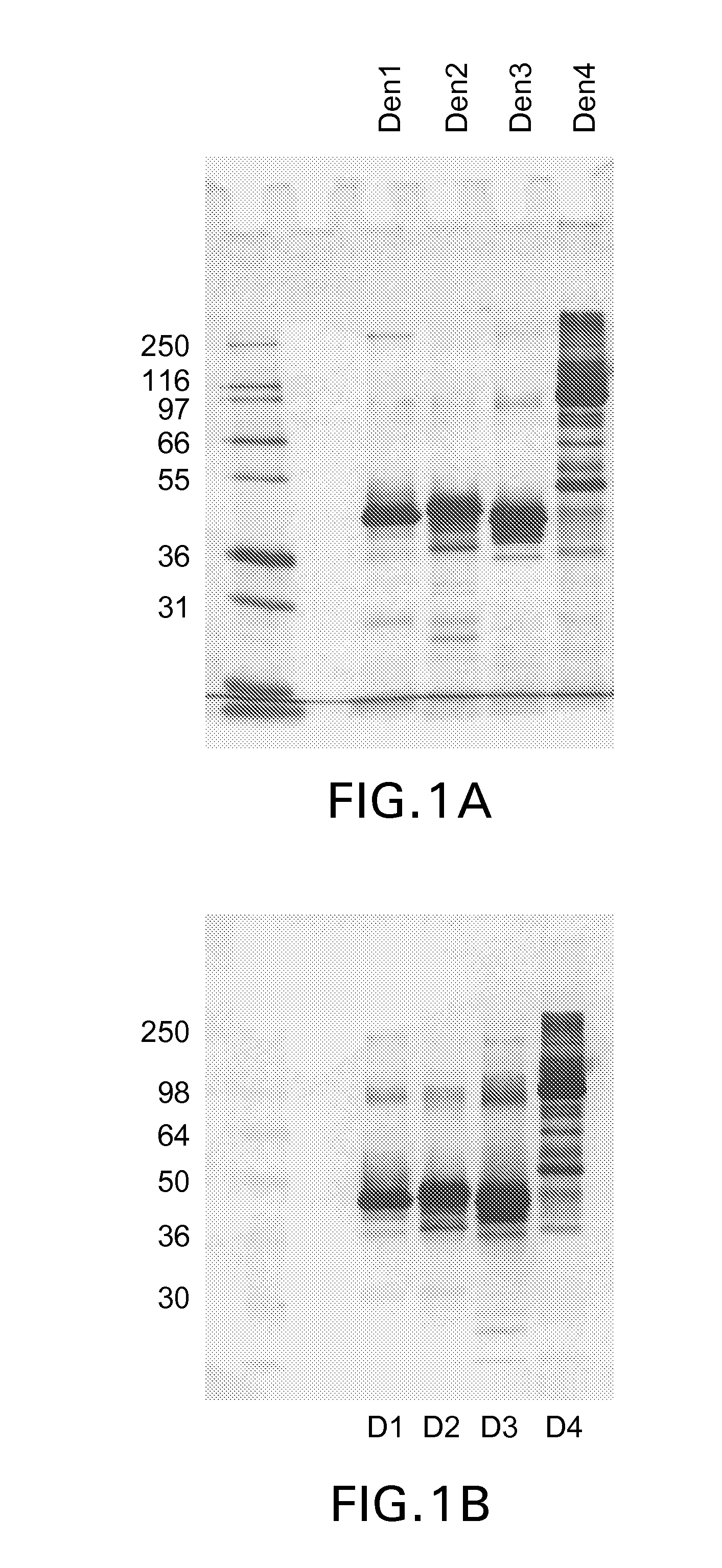Recombinant subunit dengue virus vaccine
a dengue virus and subunit technology, applied in the field of dengue virus vaccines, can solve the problems of dengue infection risk to over half the world's population, rapid onset and rapid progression of dhf/dss, and use of live-attenuated virus and inactivated virus methods to develop dengue virus vaccines, etc., to achieve the effect of preventing and/or treating diseas
- Summary
- Abstract
- Description
- Claims
- Application Information
AI Technical Summary
Benefits of technology
Problems solved by technology
Method used
Image
Examples
example 1
Expression and Purification of Dengue 80E Proteins in the Drosophila S2 System
[0097]The expression plasmid pMttbns (derived from pMttPA) contains the following elements: Drosophila melanogaster metallothionein promoter, the human tissue plasminogen activator secretion leader (tPAL) and the SV40 early polyadenylation signal. A 14 base pair BamHI (restriction enzyme from Bacillus amyloliqufacience) fragment was excised from the pMttbns vector to yield pMttΔXho that contains a unique XhoI (restriction enzyme from Xanthomonas holicicola) site in addition to an existing unique Bell (restriction enzyme from Bacillus globigii) site. This expression vector promotes the secretion of expressed proteins into the culture medium. Dengue sequences were introduced into the pMttΔXho vector using these unique BglII and XhoI sites. Dengue sequences used for studies described herein are represented by SEQ ID NO's 1-5, as follows: (1) SEQ ID NO:1; DEN1 prM-80E; (2) SEQ ID NO:2; DEN2 prM-80E; (3) SEQ ID...
example 2
Production of cGMP Lots of DEN1-80E, DEN2-80E, DEN3-80E, or DEN4-80EZip
[0102]A Master Cell Bank (MCB) was prepared from each of the S2 cell lines under cGMP conditions. The cGMP manufacturing process involves expansion of the S2 MCB cell line to a stirred tank bioreactor and then harvesting the culture medium containing the secreted protein. The cells are separated from the culture medium by filtration utilizing depth filters. The DEN1-80E, DEN2-80E, DEN3-80E, or DEN4-80EZip was then purified from the resultant clarified supernatant by immunoaffinity chromatography using the 4G2 monoclonal antibody. The immunoaffinity purification product was subsequently taken through a low pH viral inactivation step and a viral filtration step using membranes with pore sizes capable of removing 20 nm particles. The ability to take the recombinant subunit vaccine components through low pH viral inactivation and viral filtration steps is an advantage over live attenuated vaccines where this is not p...
example 3
Formulation of the HBV-001 D1 Vaccine for Use in Clinical Studies
[0105]Formulation of the monovalent DEN1-80E alum adsorbed (HBV-001 D1) vaccine was conducted under cGMP. Briefly, the purified biologic substance DEN1-80E described in Example 2 was thawed and transferred into a Class 100 laminar flow area. The DEN1-80E was diluted with sterile Dulbecco's Phosphate Buffered Saline (DPBS) to achieve a final protein target concentration of 0.20 mg / mL and the diluted 80E solution was sterile filtered. DPBS and Alhydrogel ‘85’ were volumetrically added the diluted DEN1-80E solution to a final Aluminum concentration of 2.50 mg / mL. The solution was mixed gently overnight at 2-8° C.
[0106]Following the overnight adsorption the quantity of DEN1-80E protein which was not adsorbed was determined. A minimum of 75% adsorption was required to move forward to fill of the HBV-001 D1 vaccine. The appropriate quantities of the HBV-001 D1 vaccine was transferred into prepared sterile vials. The filled v...
PUM
| Property | Measurement | Unit |
|---|---|---|
| Fraction | aaaaa | aaaaa |
| Mass | aaaaa | aaaaa |
| Volume | aaaaa | aaaaa |
Abstract
Description
Claims
Application Information
 Login to View More
Login to View More - R&D
- Intellectual Property
- Life Sciences
- Materials
- Tech Scout
- Unparalleled Data Quality
- Higher Quality Content
- 60% Fewer Hallucinations
Browse by: Latest US Patents, China's latest patents, Technical Efficacy Thesaurus, Application Domain, Technology Topic, Popular Technical Reports.
© 2025 PatSnap. All rights reserved.Legal|Privacy policy|Modern Slavery Act Transparency Statement|Sitemap|About US| Contact US: help@patsnap.com


